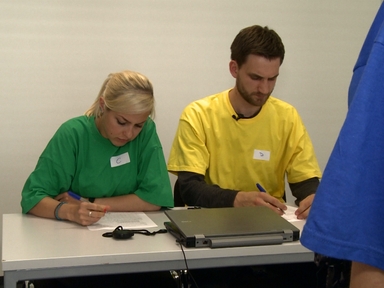The Rouge Test: Searching for a Sense of Self
Source: Laboratories of Nicholaus Noles and Judith Danovitch—University of Louisville
Humans are different from other animals in many ways, but one of the abilities that sets humans apart is their advanced ability to understand other people and simulate their thoughts and feelings, even when the thoughts and feelings do not align with their own. In scientific terms, these abilities are referred to as theory of mind, and this understanding is necessary for activities like giving compliments, working in groups, asking for favors, and telling white lies.
Humans are not born with a fully developed theory of mind. An individual’s understanding that they are separate from other people and that they have different desires and knowledge requires an established sense of self. Thus, developing self-recognition and self-awareness are some of the initial steps on the path to developing a mature theory of mind. Studying a child’s emerging sense of self is complicated, because children’s conceptual development exceeds their mastery of language. To solve this problem, researchers borrowed methods used to detect self-recognition in animals and applied them to young children. Thus, with a mirror and a bit of make-up, the rouge task was born.
This video demonstrates how researchers assess self-awareness in children at different ages.
Recruit one group of 8- to 12-month-old infants and one group of 20- to 24-month-old children. For the purposes of this demonstration, only one child is tested. Larger sample sizes are recommended when conducting any experiments.
- Make sure the participants are healthy, have no history of developmental disorders, and have normal hearing and vision.
- Because children in these age groups can be uncooperative or fussy (e.g., refuse to watch a demonstration or fall asleep during testing), it̵
In order to have enough power to see significant developmental shifts, researchers would have to test approximately 20 children per age group, not including infants dropped due to fussiness. Children who have a sense of self-recognition and self-awareness usually touch the marker on their foreheads upon seeing it in a reflection. In contrast, children who fail the test usually ignore the mark or try to touch the reflection of the mark in the mirror. Researchers also report that some children who fail the task assume they
Most children begin to show the beginnings of self-awareness just before age two. At this time, they also begin to develop a rudimentary theory of mind, including the idea that different people have different preferences and desires. Building upon this basic understanding of others’ minds, children develop to represent how other people feel, leading to the development of complex comparative emotions, such as empathy, envy, and embarrassment, and pretend play, which allow them to practice their social skills even wh
- Amsterdam, B. Mirror self-image reactions before age two. Developmental Psychobiology., 5, 297-305 (1972).
- Lewis, M., & Brooks-Gunn, J. Social cognition and the acquisition of self. New York: Plenum (1979).
Skip to...
Videos from this collection:

Now Playing
The Rouge Test: Searching for a Sense of Self
Developmental Psychology
54.1K Views

The Rouge Test: Searching for a Sense of Self
Developmental Psychology
54.1K Views

Effects of Thinking Abstractly or Concretely on Self-control
Developmental Psychology
6.5K Views

The Social Dimension of Stress: Experimental Manipulations of Social Support and Social Identity in the Trier Social Stress Test
Developmental Psychology
13.6K Views

Experimental Paradigm for Measuring the Effects of Self-distancing in Young Children
Developmental Psychology
7.8K Views

Creating Virtual-hand and Virtual-face Illusions to Investigate Self-representation
Developmental Psychology
13.1K Views
Copyright © 2025 MyJoVE Corporation. All rights reserved